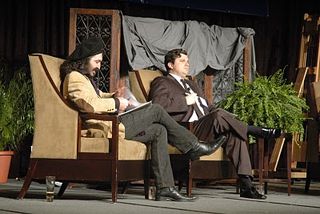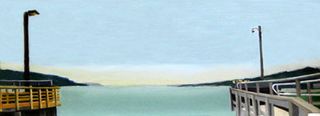
The Art Show. Photo by Holger Thoss, courtesy of ADAA
THE NEW CRITERION
APRIL 2010
Gallery Chronicle
by James Panero
On The Armory Show at the Chelsea Piers, ADAA’s Art Show & the Winter Antiques Show at the Park Avenue Armory, “William Bailey: New Work” at the Betty Cuningham Gallery & “Milton Avery: Industrial Revelations” at Knoedler & Company.
Has the art world forgotten the recession? The contemporary art fair known as The Armory Show, which took place inside two terminals on the Hudson River piers in March, certainly tried to ward off the onset of sobriety.[1] Rather than downsize, Armory went even bigger this year. The vibe was very 2007, when the art world’s money-crazed carnival was still in full swing. Nearly 300 international galleries set up shop in this warren of exhibition space. A record 60,000 visitors showed up for the five-day run. The artist Reed Seifer attempted to capture the zeitgeist with a two-ounce perfume called “Spray to Forget,” which was for sale for $25 just outside the “VIP Lounge.” Concealing current troubles with a pleasing body spray, the fair sought to remind us of the art world’s former self-intoxication and self- regard. You may have had a bad year, but, rest assured, you could still be a VIP here, along with thousands of other very important people flashing their own all-access cards.
Why should we want to jump-start the art market by embracing the tackiest commercial practices of the past? Are we concerned that new art cannot last without artificial stimulation? Art could benefit from a period of retrenchment; art that thrives in the wilderness can be the most enduring. I wish the twelve-year-old Armory Show would revisit its more humble roots, when exhibitors first rented rooms in the old Gramercy Park Hotel. Instead, it has become an unruly bazaar, dividing its extensive goods between contemporary art in the cavernous hanger of Pier 94 and modern art inside the long Pier 92—an afterthought of exhibition space that seemed decidedly less impressive than even a year ago, when this extension of the fair began.
The Armory Show has come to anchor an art extravaganza that spans the city, from a constellation of fairs to star-studded museum openings like the Whitney Biennial and an exhibition at The New Museum curated by Jeff Koons. At the same time, in a very different way, the Art Dealers Association of America hosts its own art fair known as “The Art Show” at the Park Avenue Armory. In previous years I have commented on these competing powerhouses. Both the ADAA Art Show and The Armory Show are commercial “art fairs”—ticketed conventions where galleries rent exhibition booths. Yet one manages to emphasize art (ADAA) while the other (Armory) puts a spotlight on spectacle.
Art fairs serve the purposes of art only when they seek to develop new collectors rather than make quick sales. Unlike the vast expanse of the piers, the limited acreage provided by the Park Avenue Armory—aided perhaps by the venue’s patrician environs—seems to focus the numerous fairs that rent space there each year, from the IFPDA Print Fair in November to the AIPAD Photography Show in late March.
In addition to the change in venue, what distinguishes The Art Show at the Park Avenue Armory from The Armory Show at the piers is The Art Show’s selection of exhibitors.[2] The Art Dealers Association of America, the sponsor of The Art Show, is an invitation-only member organization of America’s leading commercial galleries. Membership in this 170-gallery organization already guarantees a level of seriousness. Of these galleries, only seventy or so make the Art Show’s cut each year. Securing an exhibition space here is competitive. The result is a fair that brings together the best American galleries under one roof, each presenting excellent mini-exhibitions.
If The Armory Show is about horse-trading and blockbuster openings, the more collegial Art Show is about building relationships. The galleries are on display as much as the art on their walls. The best exhibitors at ADAA assemble focused shows, either around formal themes or single artists.
This year June Kelly presented “The Primacy of Color” with a show-stopping new abstraction by James Little. Hans Kraus was back, this time with nineteenth-century photographs of open landscapes. The solo shows ranged from Shirley Jaffe (Tibor de Nagy) to April Gornik (Danese), Jacob Lawrence (DC Moore), William Kentridge (Marian Goodman), Martin Kippenberger (David Nolan), and Alighiero e Boetti (Sperone Westwater). Galerie St. Etienne featured an exhibition of nude drawings by Gustav Klimt and Egon Schiele, where the confidence of Schiele’s late line (from the 1910s) still astonishes.
The Art Show wasn’t the first excellent fair at the Park Avenue Armory in 2010. That distinction belongs to the Winter Antiques Show, which ran for more than a week in late January.[3] This fair only gets better as it expands its range year by year. The Winter Antiques Show has long offered everything from antiquarian books (Bauman) to arms and armor (Peter Finer), American folk art (Giampietro), master portraits (this year, Rembrandt Peale’s George Washington at Hirschl & Adler), and Indian art of the Pacific Northwest (Donald Ellis).
By not limiting the work to just paintings or prints, the fair allows its vendors to turn their booths into complete domestic spaces, filled with furniture and decorative objects. The best exhibitors create full dioramas of their pieces in private settings. Hostler Burrows, which specializes in Scandinavian furniture and houseware, decorated its booth with wallpaper by the mid-century Swedish designer Josef Frank. Hans Kraus Fine Photographs put together a museum-quality show of the photographs of William Henry Fox Talbot that included a replica of the oriel window at Talbot’s Wiltshire home, Lacock Abbey—the subject of one of Talbot’s first photographs from 1835—as well as a handful of haunting photographic etchings.
This year the fair wisely advanced its cut-off date to include collectible work made through the late 1960s. The move allowed the first-time exhibitor Lost City Arts to display a remarkable selection of hand-made metal sculpture by Harry Bertoia, including a few of his “sonambient” sculptural instruments.
Whether by luck or by design, many galleries around the city seem to schedule their more important shows around the March run of the fairs. Woodward Gallery mounted a shimmering survey of recent abstractions by Natalie Edgar, an artist who once studied with Mark Rothko and Ad Reinhardt. Lesley Heller Workspace brought some of Austin Thomas’s Bushwick artists to the Lower East Side. The ambitious large paintings of Noah Landfield and Sara Klar went up at Sideshow Gallery.
Betty Cuningham Gallery featured its third exhibition of nudes and still lifes by the painter William Bailey.[4] This artist’s limited subject matter and reserved paint handling have often been seen as conservative challenges to the orthodox radicalism of modern art. The meaning of Bailey’s work as it relates to the history of art has been a subject of debate since his painting first appeared on the cover of Newsweek in the early 1980s. At the time Bailey was hailed as one of the new artists “of the real.” For me, such discussions have limited utility. They may give Bailey an aura of relevance, but they do little to explain the mysterious power of his work.
Like Giorgio Morandi, another great modern realist, Bailey imbues quiet paintings with intense energy. The latest Cuningham show, with its equal pairing of still lifes and nudes, pointed me to the sensuous sources of Bailey’s dynamics. Bailey’s work is so surprising, so novel, when compared to the canon of modern art because its fecundity shows no limit or irony. The egg shape that appears repeatedly in his still lifes and reappears in his nudes and figurative work, for example as the door knob in House by the Sea (2009), comes across as a central motif. The egg recalls the curved vessels of his still lifes and the rounded faces of his figures. One could even say the motif appears again in the egg-shell finish Bailey meticulously applies to every square inch of his canvas.
As a teacher at Yale, Bailey trained a generation of younger artists to paint in the realist mode. The Cuningham show suggests that more than merely reviving lost technique, Bailey’s lasting legacy may be his concern for the sensuousness of the female form. Artists like John Currin and Lisa Yuskavage never inherited their master’s fine hand, but they took Bailey’s primary theme and made it their own through exaggeration and farce. Bailey may not be as well-known as some of his pupils, but his simple work is all the more extraordinary and enduring.
A revelatory exhibition at Knoedler of Milton Avery’s work from the 1930s called, appropriately, “Industrial Revelations ” examines the machine-age origins of this modernist painter of color and countryside.[5] A poor artist searching for subject matter beyond his Upper West Side studio, Avery roamed New York in his early years. He settled on the railroad tracks, bridges, and waterways at the edges of the city. Absent bright colors and his signature hatched paint handling, the work that came out of these wanderings reveal the artist’s uncanny understanding of composition. Avery distilled each landscape down to squares and curves. Over a solid square structure, the arcing bridges, railroad beds, water towers, and tugboat wheelhouses bend the eye across the canvas. The result is an artist already working in an essential mode.
I had always thought Avery did not hit his stride until the 1940s, but the Knoedler show suggests he reached a mature style much earlier. I doubt the gritty results will win over those who expect salmon landscapes, but paintings like Under the Bridge (c. 1930) and Railroad Yards (1931) and watercolors like Under the Bridge/Houseboat (c. 1930s) are treasures. They also remind us that this great artist once gazed along the banks of the Harlem River, looked out over the West Side El, and changed the course of American art through what he saw by building a bridge from the American Scene to the abstract art of mid-century.
It should be noted that the name of Knoedler’s former director Ann Freedman does not appear in the show’s catalogue, but her fingerprints seem to be all over it; while “Industrial Revelations” is extensive, her departure from the gallery last fall leaves this show with its only absence.
Notes
Go to the top of the document.
- The Armory Show 2010 was on view at Piers 92 and 94, New York, from March 3 through March 7, 2010. Go back to the text.
- The Art Show was on view at the The Park Avenue Armory, New York, from March 3 through March 7, 2010. Go back to the text.
- The Winter Antiques Show was on view at the Park Avenue Armory, New York, from January 22 through January 31, 2010. Go back to the text.
- “William Bailey: New Work” was on view at Betty Cuningham Gallery, New York, from February 18 through March 27, 2010. Go back to the text.
- “Milton Avery: Industrial Revelations” opened at Knoedler & Company, New York, on February 18 and remains on view through May 1, 2010. Go back to the text.


